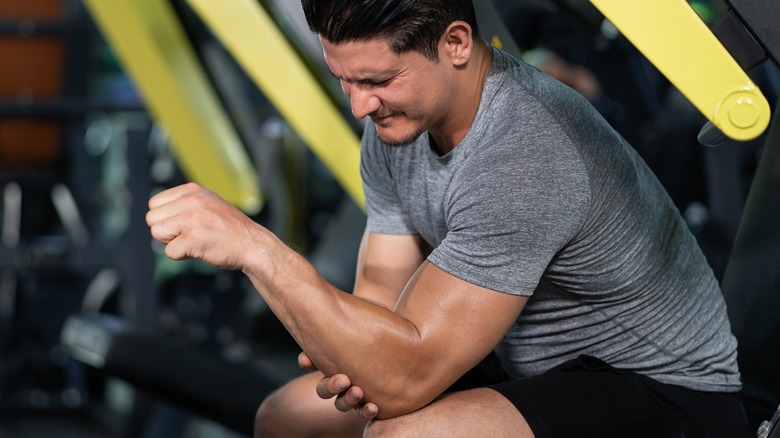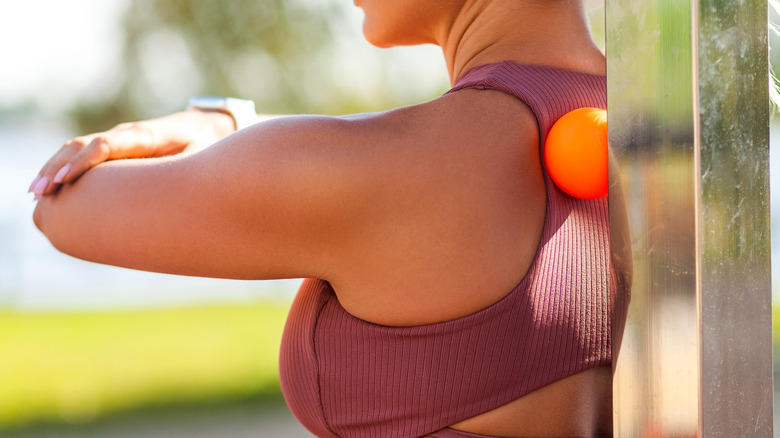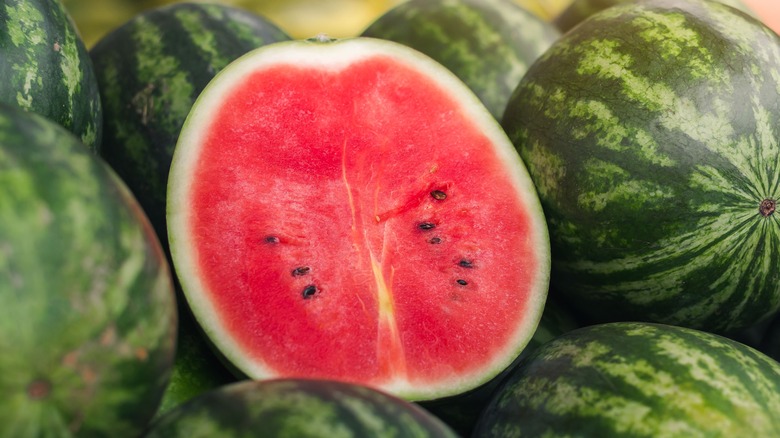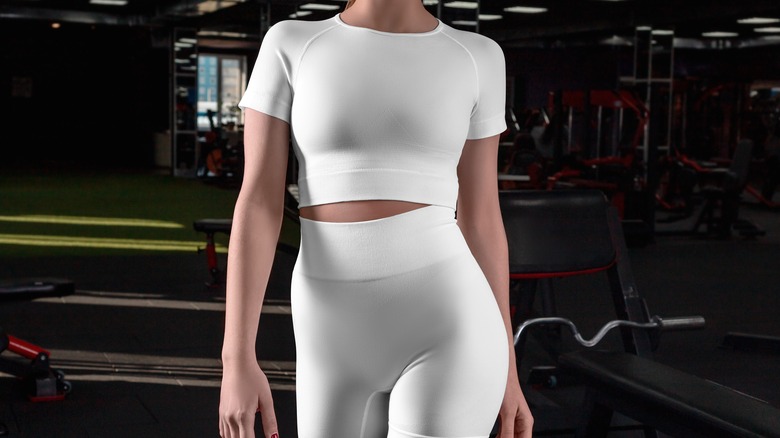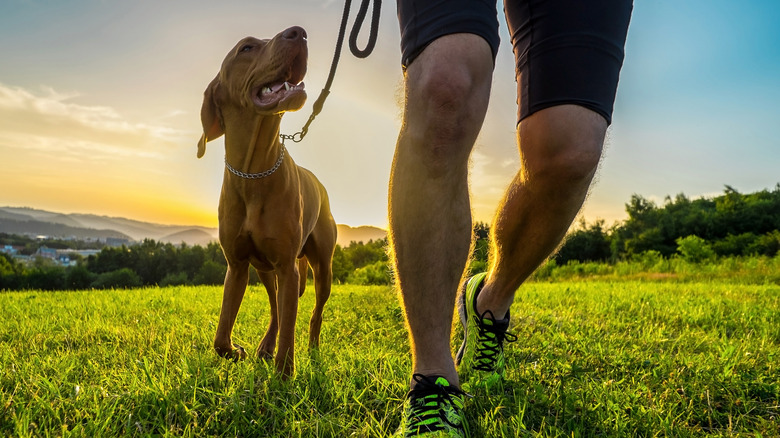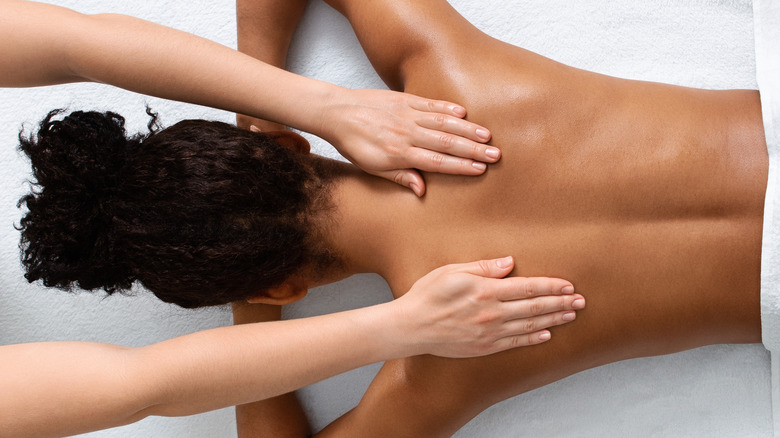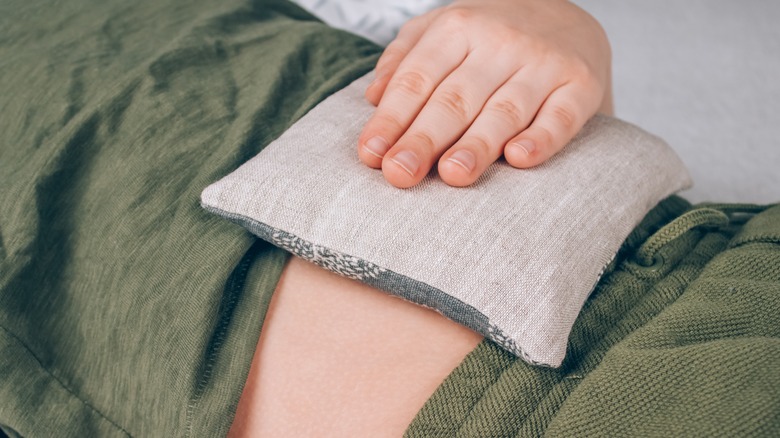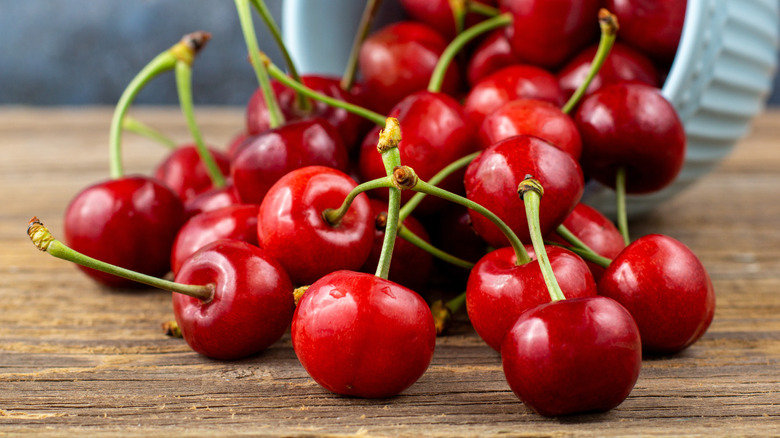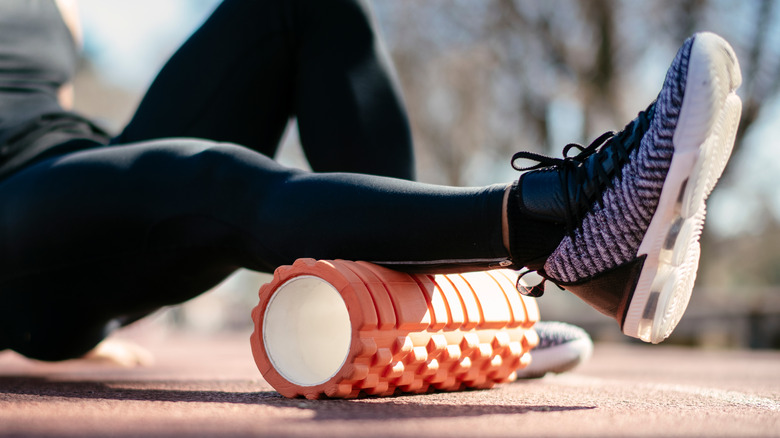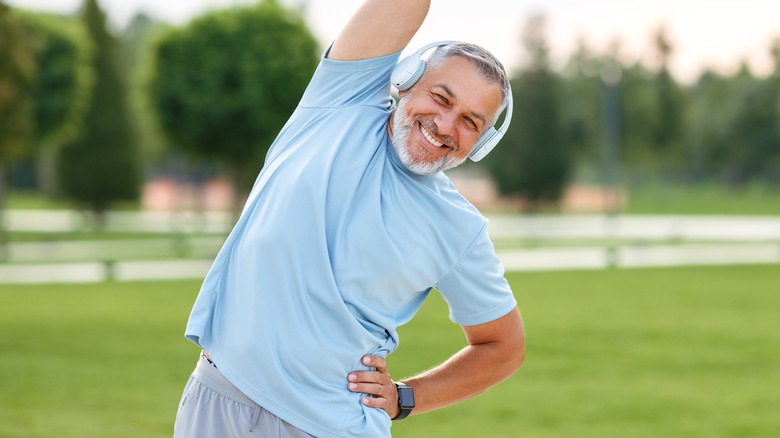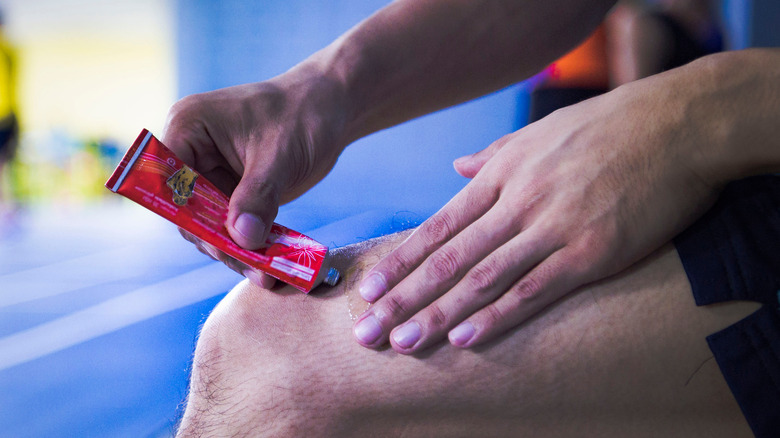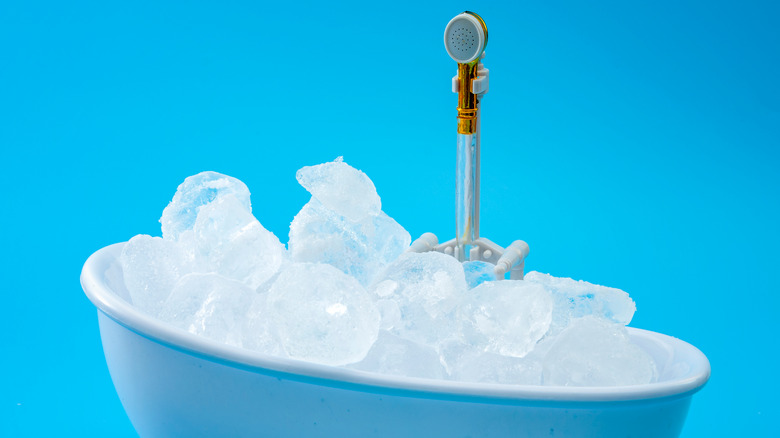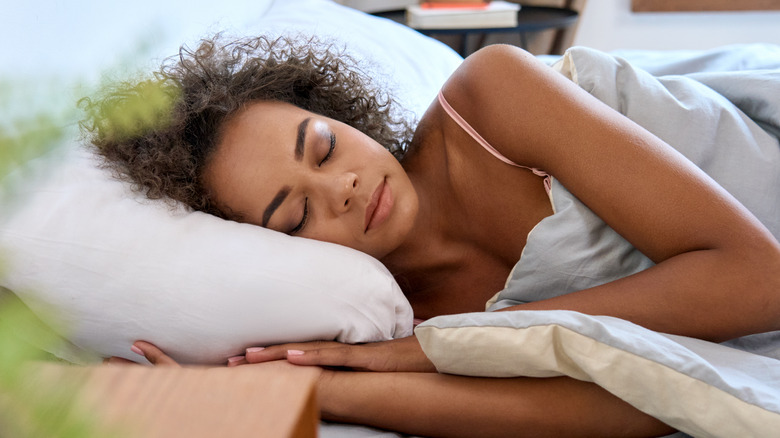What You Can Do To Ease Sore Muscles After A Workout
A good workout is the stuff of dreams. That endorphin rush afterward, the feeling that you've just totally smashed your personal best, and the sense that you've got your money's worth in the gym? Can't beat any of that. But the soreness that starts to appear shortly after you're done with your workout is, shall we say, slightly less dreamy. Sore muscles post-exercise, also known as delayed onset muscle soreness (DOMS), is something that a lot of people will be familiar with, with symptoms manifesting between 12 and 72 hours following a workout (per the American College of Sports Medicine).
DOMS appears, as you might expect, through soreness and tenderness in your muscles, and depending on how long it's been since you worked out and how hard you exercised, it can be pretty painful. But what if you want to exercise again straight away without these aches and pains — or, maybe slightly more realistically, what if you just don't enjoy them?
Luckily, there are a host of ways you can reduce your muscle soreness after working out, and some of them might be easier than you think. Let's take a look at what you can do to soothe your aching muscles.
Why do our muscles get sore after a workout?
When you first notice that your muscles are killing you after a workout, the first instinct can be to panic, or at least feel a little unsettled by the pain ricocheting around your body. But fear not — DOMS is entirely normal, and is actually a sign of muscle repair. When you work out, your muscles start to sustain tiny tears throughout them, caused by the impact of your workout (per the National Kidney Foundation). It's this breakdown of muscle that causes the soreness through them, which indicates that your muscle is actually repairing itself and is building back stronger.
So nothing to worry about — unless the pain feels a little too extreme or lasts a little longer than you think it should. While DOMS will generally clear up within a few days, pain caused by injury may last longer, and may rear its head again when you start working out again (via SELF). The type of pain you're experiencing is also a sign that it could be something more serious. "Soreness is more of a tender, tired, or even burning feeling," says NYU Langone Medical Center assistant professor of orthopedic surgery Dr. Claudette Lajam. "When people are truly injured, they'll have sharp, stabbing, deep pains. Those are the ones that are signs it might be more serious."
Resting is essential
Okay, so here it is, folks, the thing you've all been waiting for: We hereby permit you to rest. This permission isn't just because we can see that you've been working hard, and thus deserve the break (and even if you weren't working that hard, you deserve the break, too). It's also because resting is one of the best things you can do for muscle soreness.
When you rest, you give your muscles the chance that they need to heal, which will inevitably reduce muscle soreness as they come back bigger and stronger (per Everyday Health). Moreover, you must rest to rebuild the stamina and energy you need to hit the gym even harder next time, according to Mount Sinai Hospital orthopedic surgeon Dr. Melissa Leber.
Resting isn't just important because it'll help reduce muscle soreness; it's also vital to prevent worse soreness down the line. Without resting, you're overexerting your body, which is also known as overtraining. "Overtraining can lead to overuse, which can lead to burnout and injury," Leber warns. These injuries, which can include stress fractures and muscle strain, might have you feeling the pain for even longer, and put you out of action exercise-wise.
Making sure your diet is in good shape will help promote muscle recovery
Diet is often frustratingly overlooked when it comes to exercise — and when it isn't overlooked, most people are concerned with how their diet will give them energy or help their gains. But your diet can also have a huge effect on how quickly you recover, as well as the amount of soreness you'll feel while you do so.
Ensuring that you're eating a diet that's rich in protein, omega-3 fatty acids, and specific vitamins and minerals will assist in limiting DOMS and promote faster muscle rebuilding, according to Healthline. Eating fatty fish, like trout and salmon, is especially good for this. The protein in the fish will help your muscles repair themselves and build back stronger, while the omega-3s can bring down the inflammation and soreness that occurs after working out hard, according to research published in the Journal of Exercise Rehabilitation.
And don't forget about your fruits and vegetables, folks. By eating starchy potatoes with rich carb content (like butternut squash and sweet potatoes), you're giving your muscles a chance to restore their glycogen levels, which allows you to bounce back faster for your next exercise session (per research published in Nutrients). Nutrient-rich fruit like watermelon may also promote faster muscle recovery, enhanced by the hydration the water levels in the fruit provides.
Wearing compression gear may ease soreness
Wearing the right clothing when you work out is essential to the success of your exercise session. But what you wear after exercise can also make a big difference, especially in terms of post-workout soreness.
Wearing compression gear when you're sore after a workout can promote more circulation to your muscles, according to "GOOD TO GO: What the Athlete in All of Us Can Learn from the Strange Science of Recovery" author Christie Aschwanden (via Men's Health). The blood flowing to your muscles can help them recover faster. Compression gear can also lessen the amount of fluid buildup and swelling experienced in your muscles after exercise, and limit the quantity of the pain-inducing enzyme creatine kinase, according to research published in Sports Medicine.
And aside from that, compression gear might just be nice to wear when you're feeling the ache. "The thing about compression gear is that it can feel good," Aschwanden explains. "One of the most important parts of recovery is just giving your body the chance to feel good and relax and if wearing compression gear helps you feel better, that can be worth doing even if there isn't a physiological reason for it." Honestly, we can get on board with that logic!
Continuing with gentle exercise can lessen pain
When you're feeling especially achy, it can be very tempting to just your feet up and lie very, very still until it passes. And while resting will certainly help your muscles recover, don't be afraid to move around a little. Although exercising with muscle pain might seem like you're going to make it feel even worse, this actually promotes circulation and gives your muscles the blood they need to hasten the healing process, according to Healthline.
While it's entirely possible to work out when you're sore, you should focus on the body parts you didn't work on last time, to avoid overexerting them. For recovery exercises, it's hard to go wrong with stretching. "People don't stretch enough," says Iowa State University's professor of exercise physiology Rick Sharp, who points out that stretching can elongate the muscles and prevent further tightness or cramps (via WebMD). It's also useful to perform easygoing full-body exercises, like gentle bike riding, swimming, or walking, to get your blood moving around your body.
Get yourself a massage
Has it been a while since you've treated yourself to a massage? Have you ever treated yourself to a massage? If not, and if you're worried about feeling especially achy the day after a hard workout, now is the time to do it, folks.
Getting a massage is far from an indulgence after exercise: It can actually promote recovery pretty significantly. A study published in the Journal of Athletic Training examined the effects of receiving a 10-minute massage approximately three hours after finishing an arm workout. It found that for the participants who received the massage, the painful, sore symptoms of DOMS were reduced by almost a third.
Additionally, the study's authors found that massaging muscles after a workout also decreased the overall swelling the muscles exhibited, without any limiting of muscular function. This study was particularly interesting, as the massages were performed before any achiness even started, given the fact that DOMS usually exhibits symptoms around 8-24 hours after a workout. While the authors were unclear on exactly how the massages decreased DOMS, one of the reasons could be the increased circulation generated by the activity in the muscles.
Apply some heat
Anyone who's woken up the day after a hard workout and has struggled to swing themselves out of bed, with their muscles groaning and immobile, will know the feeling of stiffness that often accompanies post-exercise soreness. But heating your muscles can not only make you feel a bit more limber, but also reduce symptoms of pain.
Grab yourself some heating pads to tackle that soreness, suggests Cleveland Clinic exercise physiologist Katie Lawton (via Men's Health). "The idea behind heating pads is that they increase blood flow because it is a vasodilator (opens up your blood vessels), and is thought that it could help flush some of the byproducts or inflammation related to muscle soreness out of the muscles," Lawton explains.
Heating pads, and heating your muscles in general, will also promote better blood flow to your muscles, not only flushing the bad stuff out but getting the good stuff (like oxygen) in. And aside from that, warming up your muscles just feels good — much better, for a lot of people, than an ice bath, another traditional method of reducing muscle soreness.
Drinking some tart cherry juice may help
Who'd have thought that the secret to reducing your muscular soreness could be found in a simple glass of juice? It might sound too good to be true, but drinking tart cherry juice may have a particularly potent effect on the severity of your DOMS.
Research published in the Journal of the International Society of Sports Nutrition examined what would happen to muscle soreness in runners if they were given tart cherry juice for a week before their long running event, drunk both before and during the run. The people who drank the juice noticed that after the event, their muscle soreness was lower.
But ... why? Don't worry, we were confused too, but the researchers had a few thoughts about how tart cherry juice does this. The cherries that the juice comes from have especially potent antioxidants, as well as anti-inflammatory nutrients. The scientists leading the study reasoned that while further research is needed to determine exactly why and how tart cherry juice is so effective, these compounds could have a lot to do with it. Raise a glass, folks!
A foam roller will provide relief
Look. We hear you. We don't like using foam rollers either. They hurt. A lot. However, we're sorry to be the bearers of bad (but also kinda good?) news: Using a foam roller is really, really good for you, especially when it comes to muscle soreness after exercise.
Researchers found that foam rolling significantly reduced DOMS and improved recovery the day after exercise when folks rolled them across their thighs following a round of squats (per research published in the Journal of Athletic Training). It should be pointed out, though, that participants in the study had to perform three rounds of rolling, for twenty minutes each, for their benefit. Ouch.
Essentially, foam rollers give you a self-controlled massage, working their way into your muscles to help to rehabilitate them. It's worth noting that reduced muscle soreness isn't the only thing a foam roller can assist with. Regular foam rolling may improve your flexibility and range of motion, lessen the appearance of cellulite, and could even allow people to manage fibromyalgia symptoms better, according to Healthline.
Staying hydrated is key
A strong exercise regime is nothing without proper hydration. (We mean, nothing in this world is anything without proper hydration, but we're discussing exercise here, people). Drinking enough – but not too much – water before and during exercise allows you to perform optimally with enough energy, supply your muscles with the hydration they need, and retain the mental focus needed to get through your workout (per BetterHealth).
After exercise, replenishing lost fluids and maintaining proper hydration is essential to aid recovery and keep muscle soreness down. "Even mild dehydration can make your DOMS worse," warns ultrarunner and sports dietitian Alexandra Cook (via The Guardian). Just like the rest of your body, your muscles are made up of a high amount of water, and losing this water can have adverse effects and increase pain. It should be said, however, that keeping on top of your hydration may not necessarily speed up your recovery from DOMS — but it might reduce pain, and let's face it, that's very appealing.
Make sure you warm up before your exercise — but a cool-down may not be that helpful
How many of you warm up before working out? Show of hands, please. Okay, great. Now be honest: How many of you actually do it? If you're one of those people who had a moment of self-reflection and realized that you spring into a full five-mile jog without warming up first, we advise you to reassess your pre-workout routine.
A study published in the Journal of Human Kinetics examined the effects of warming up before resistance exercise and its impact on DOMS. It was found that the people who warmed up well before exercise, using aerobic movements, experienced way less muscle pain in the period after, without diminishing their muscular power.
Cool-downs, however, were a slightly different matter. Researchers found that although cool-downs after working out did help to reduce muscle soreness somewhat, it was the people who warmed up who experienced the most benefit, suggesting that warm-ups are more effective for DOMS prevention. It's worth pointing out, too, that if you're always pressed for time before a workout, a good warm-up doesn't need to take that long at all. Performing cardio exercises for 5-10 minutes should be more than enough to get the blood pumping, help your body achieve a state of readiness, and reduce soreness post-pump, according to Harvard Health Publishing.
Apply some topical treatment
A lot of strategies for managing muscle soreness after exercise focus on treating it from the inside out: eating the right things, getting your blood flowing, and resting to allow your muscles to repair themselves. Now, don't get us wrong, these are all great strategies. But treating from the outside in, via topical treatments, can also be a great way to ease pain, according to Healthline.
More specifically, you should try and seek out creams and ointments that contain two key ingredients, menthol or arnica. Arnica, a herb frequently used in formulations to treat osteoarthritis pain, can also be super effective in reducing muscle soreness, particularly in pain that lasts 72 hours or beyond, which is when it seems to be most effective (per a study published in the European Journal of Sport Science). Menthol-based gels have also been found to be effective in reducing pain, according to research published in Medicine & Science in Sports & Exercise.
Remember, though, that with any gel or cream that you're using, it's important to follow the manufacturer's instructions, and to make sure that you're not applying it too liberally. Always consult with a doctor if you have any doubts about applying topical medication.
A cold bath might be shocking, but it'll reduce your soreness
As it turns out, there's a very solid reason why soccer stars, tennis pros, and gymnasts alike favor an ice bath following a hard workout: It's pretty good for your muscles.
A study published in Sports Medicine examined the effects of cold water immersion on muscle soreness, comparing it to passive recovery to assess its efficacy. It was found that submerging your muscles in cold water helped to manage DOMS more effectively. What was especially interesting was that the temperature of the water and the time spent in it seemed to affect how much benefit it provided to your muscles. The optimal temperature, researchers found, was between 11-15 degrees Celsius, and the perfect time to spend in it was between 11 and 15 minutes. So probably a little longer than you might like, but trust us, it's good for you.
Plus, cold water immersion isn't just good for muscle soreness. Regularly submerging your body in cold water could also boost your immune system, and may even ease symptoms of depression, although it should be pointed out that it's not a specific treatment for mental health conditions (per Healthline).
If you or someone you know needs help with mental health, please contact the Crisis Text Line by texting HOME to 741741, call the National Alliance on Mental Illness helpline at 1-800-950-NAMI (6264), or visit the National Institute of Mental Health website.
Sleep it off
If all else fails? Get back into bed and pull the covers over you. This might be a generally good rule for life, but as it turns out, it's also a great thing to do when your muscles are feeling particularly ragged after that HIIT class.
"It's really important to prioritize sleep because sleep is really when your body does the hard work of recovery," states "GOOD TO GO: What the Athlete in All of Us Can Learn from the Strange Science of Recovery" author Christie Aschwanden (via Men's Health).
When we go to sleep, our body goes to work repairing and growing our muscles, releasing growth hormone to do so (per Healthline). Without proper sleep, our recovery process takes longer, leading to prolonged muscle soreness. Sleeping poorly, or not sleeping enough, can also increase inflammation throughout the body, a key factor in DOMS (via Science Daily). In short, sleep is essentially the first thing you should be doing. "If you're spending a lot of money on things like a massage gun and tart cherry juice but are only getting six hours of sleep a night, you're really shooting yourself in the foot," says Aschwanden (via Men's Health).

